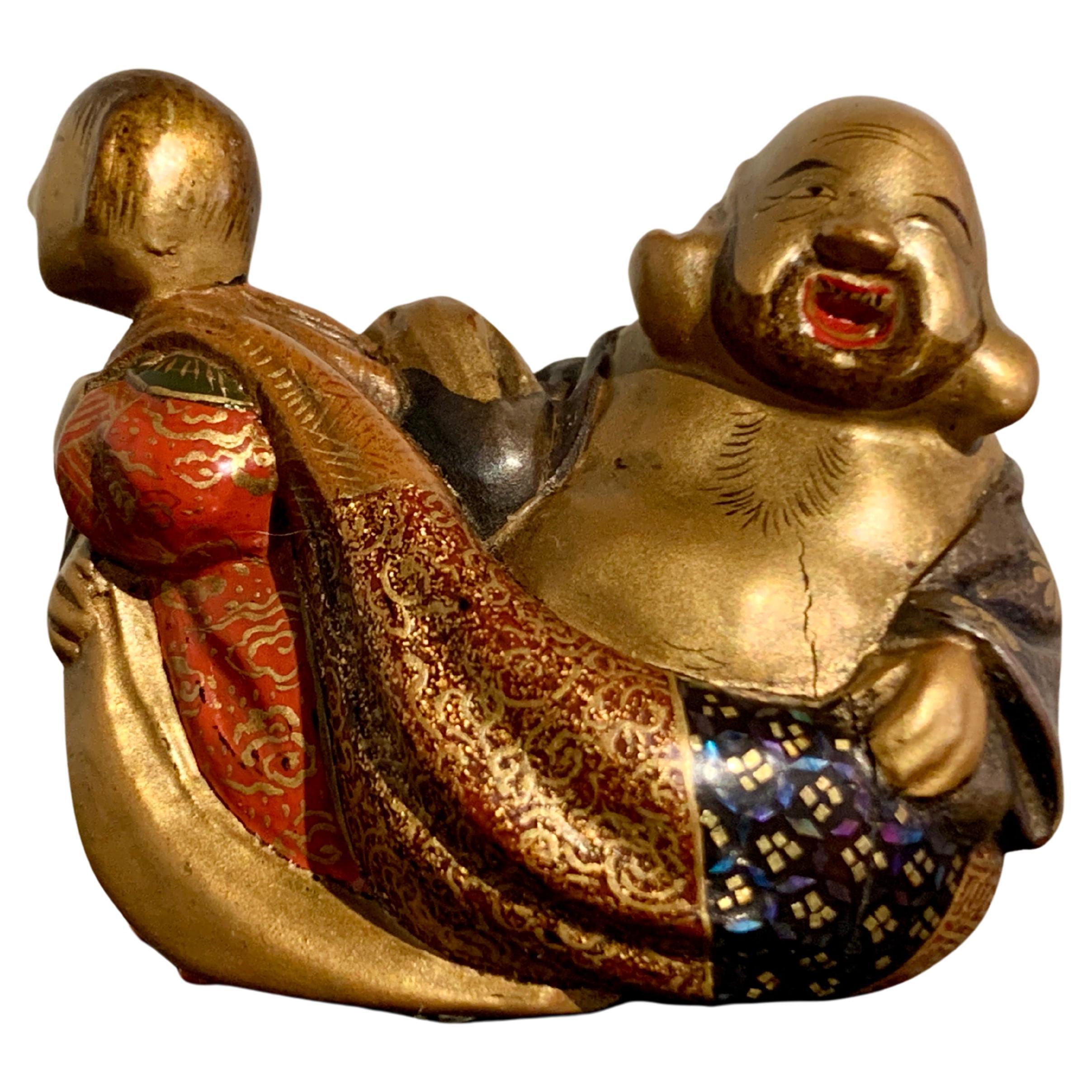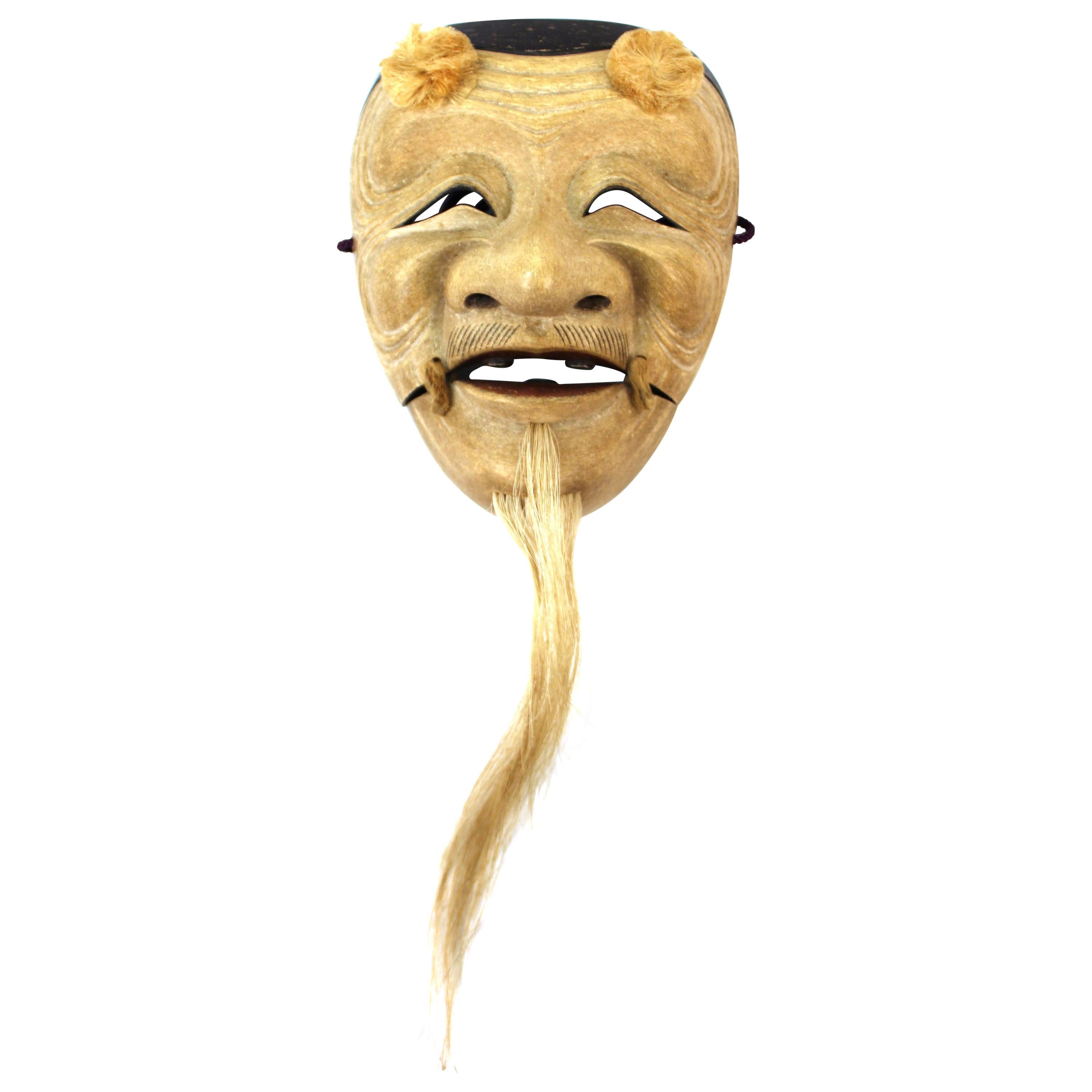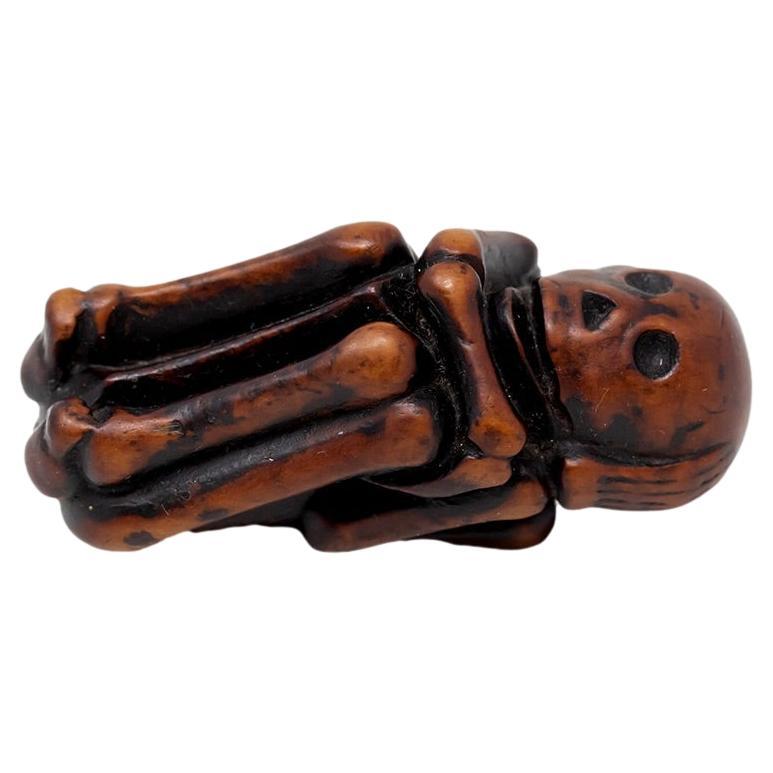Items Similar to Carved Boxwood and Lacquer Netsuke of a Noh Dancer, Meiji Period, Japan
Want more images or videos?
Request additional images or videos from the seller
1 of 12
Carved Boxwood and Lacquer Netsuke of a Noh Dancer, Meiji Period, Japan
About the Item
A fine lacquer decorated carved boxwood netsuke of a Noh dancer in a Hannya role, unsigned, Meiji period, late 19th century, Japan.
The boxwood netsuke finely carved as a kneeling Noh dancer dressed in striking geometric patterned robes. The actor holds an opened war fan behind their back in one hand, a Shinto wand slung over the shoulder in the other.
The war fan, tessen, decorated in red lacquer with a golden rising sun at the center. Tessen were sturdy fans used by samurai as protective devices, and sometimes as weapons.
The wand, called an onusa, is a traditional Shinto ritual implement comprised of folded paper streamers, shide, attached to a wooden wand, often used in purification rituals. Here, the shide are crafted from silver maki-e, with the handle of the natural boxwood.
The actor wears a fierce and unearthly hannya mask, the grotesque face fixed with a predatory smile. A mane of long hair frames the face and extends down the back.
Hannya characters in Noh dramas portray scorned women consumed by jealousy and anger, transforming them into demons.
Netsuke are small Japanese sculptures originally used to secure sagemono and inro, traditional carrying pouches and cases, to belts or sashes.
- Dimensions:Height: 1.88 in (4.78 cm)Width: 1 in (2.54 cm)Depth: 1.13 in (2.88 cm)
- Style:Meiji (Of the Period)
- Materials and Techniques:
- Place of Origin:
- Period:
- Date of Manufacture:circa 1890
- Condition:Wear consistent with age and use. Minor fading. In very good condition. No cracks, chips or repairs noted. Minor wear to the gilt lacquer. The silver maki-e tarnished.
- Seller Location:Austin, TX
- Reference Number:1stDibs: LU894731119222
About the Seller
5.0
Platinum Seller
These expertly vetted sellers are 1stDibs' most experienced sellers and are rated highest by our customers.
Established in 2001
1stDibs seller since 2010
306 sales on 1stDibs
Typical response time: 1 hour
- ShippingRetrieving quote...Ships From: Austin, TX
- Return PolicyA return for this item may be initiated within 7 days of delivery.
More From This SellerView All
- Boxwood and Lacquer Netsuke of Hotei by Shunsho, Meiji period, circa 1900, JapanLocated in Austin, TXA charming and finely decorated carved and lacquered boxwood netsuke of Hotei by Shunsho (probably Shunsho XI, Masaoki), Meiji period, circa 1900, Japan. This delightful and colorful netsuke features the beloved figure Hotei, one of the Seven Lucky Gods. The god of fortune and happiness is seated upon his treasure bag, and being dragged by a smiling child. Carved from boxwood and decorated in bright lacquers of gold, silver, red, black and green. Hotei's chest and ample stomach mostly exposed, his skin covered in gold lacquer. Large elephantine ears frame his bearded face. His red-lipped mouth open in an uproarious laugh. Hotei's treasure bag formed as a patchwork of various brocades in gold, red, and black lacquer. The black lacquer further decorated in the lac burgaute...Category
Antique Early 1900s Japanese Meiji Sculptures and Carvings
MaterialsBoxwood, Lacquer
- Japanese Tokyo School Bronze Okimono of a Farmer, Meiji PeriodLocated in Austin, TXA very fine and detailed Tokyo School cast bronze okimono (decorative sculpture) of a smiling farmer, Meiji period, late 19th century, Japan. The e...Category
Antique Late 19th Century Japanese Meiji Sculptures and Carvings
MaterialsBronze
- Japanese Miyao Style Gilt Bronze Samurai Archer, Meiji Period, JapanBy Eisuke Miyao 1Located in Austin, TXA spectacular Japanese cast, carved, and parcel gilt bronze sculpture, okimono, of a kneeling samurai archer, signed Kiyotsugu (died 1894), Meiji ...Category
Antique Late 19th Century Japanese Meiji Sculptures and Carvings
MaterialsBronze
- Japanese Gilt Wood Fukukenjaku Kannon, Meiji Period or Earlier, JapanLocated in Austin, TXAn attractive and esoteric Japanese carved and gilt wood figure of Fukukenjaku Kannon, Amoghapasa, Meiji period or earlier, Japan. Fukukenjaku Kannon is portrayed in an usual six...Category
Antique Early 1900s Japanese Meiji Sculptures and Carvings
MaterialsCypress
- Pair of Japanese Gilt Bronze Komainu by Ishikawa Komei, Meiji PeriodLocated in Austin, TXA striking pair of Japanese gilt bronze komainu by the renowned Japanese sculptor, Ishikawa Komei (1852-1913), Meiji period, Japan. The pair well cast, and robustly modeled. They ar...Category
Antique Late 19th Century Japanese Meiji Sculptures and Carvings
MaterialsBronze
- Japanese Carved and Lacquered Wood Shogun, Edo Period, 19th Century, JapanLocated in Austin, TXAn unusual Japanese carved wood, lacquer, and gilt decorated portrait sculpture of a shogun, Edo Period, early 19th century, Japan. The unidentified shogun (possibly Tokugawa Iey...Category
Antique Mid-19th Century Japanese Edo Sculptures and Carvings
MaterialsWood, Lacquer
You May Also Like
- Japanese Meiji Noh Mask in Carved WoodLocated in New York, NYJapanese early Meiji period Noh theater mask made of carved wood with gofun layers. The piece was made in Japan in circa 1880 and is signed on the back. In great antique condition wi...Category
Antique 1880s Japanese Meiji Sculptures and Carvings
MaterialsWood
- Japanese Meiji Noh Mask of OkinaLocated in New York, NYJapanese carved wood Noh mask depicting Okina. The piece was made during the late Edo - early Meiji period in the 19th century. The mask is of an older man wi...Category
Antique 19th Century Japanese Meiji Sculptures and Carvings
MaterialsWood
- Japanese Skeleton Boxwood Netsuke Late Edo PeriodLocated in Newark, EnglandJapanese boxwood netsuke depicting a skeleton. The skeleton naturalistically carved in the foetal position in preparation for transitional burial. With...Category
Antique Mid-19th Century Japanese Edo Sculptures and Carvings
MaterialsWood, Boxwood
- Japanese Meiji era chestnut netsukeLocated in PARIS, FRWooden netsuke featuring a group of three chestnuts. One of them reveals a tiny hole and the head of a small worm in bone inlay, offering a very naturalistic representation. Chestnu...Category
Antique Late 19th Century Japanese Japonisme Sculptures and Carvings
MaterialsBoxwood
- Meiji Period Carved Lion and TigerLocated in Pasadena, CAThis is an outstanding pair of Meiji Period carved hardwood figures of a ferocious lion and tiger. The carving is exceptional as is the bone detailing of the mouthes and teeth. The f...Category
Antique Late 19th Century Japanese Meiji Animal Sculptures
MaterialsBone, Hardwood
- Japanese Meiji Period Carved Wood Okimono Man with RabbitsLocated in Newark, EnglandThe charming figure, carved from a single piece of wood is exceptionally carved showing the male figure with humorous expression holding two Rabbits one by the ears and the second under his arm. A third Rabbit stands at the feet of the male looking up, each rabbit with a different expression. The male figure is wearing traditional Japanese attire with his hair tied back stood upon a naturalistic base. The figure dates to the Meiji Period (1868-1912) circa 1900. Notes The Rabbit is one of the 12 animals to feature in the Japanese Zodiac signs which follows the Chinese astrological system along with the Rat, Ox, Tiger, Rabbit, Dragon, Snake, Horse, Goat, Monkey, Rooster, Dog, Pig. Such division is connected with the Jupiter cycle around the Sun, which lasts about 12 years. As 2023 is the year of the Rabbit...Category
Antique Early 1900s Japanese Meiji Sculptures and Carvings
MaterialsWood
Recently Viewed
View AllMore Ways To Browse
Antique Boxwood
Hand Carved War
Antique Hand Fan Hand Fans
Antique Fan Hand
Antique Fans Hand Fans
Antique Hand Fans
Antique Hand Fan
Hand Fan Antique
Japanese Hair
Wooden Sculpture Japanese
Wears A Mask
Asian War
Red Lacquer Sculpture
Japanese Silver Sculpture
Japanese Wooden Carved
Japanese Hand Carved Wooden
Japanese Fan Art
Japanese Meiji Carving





